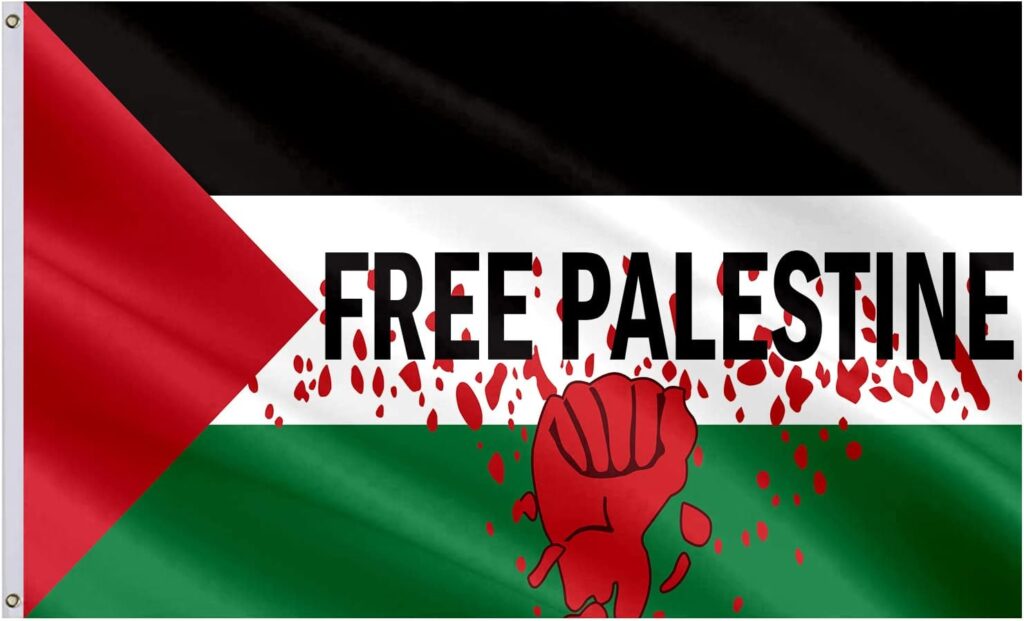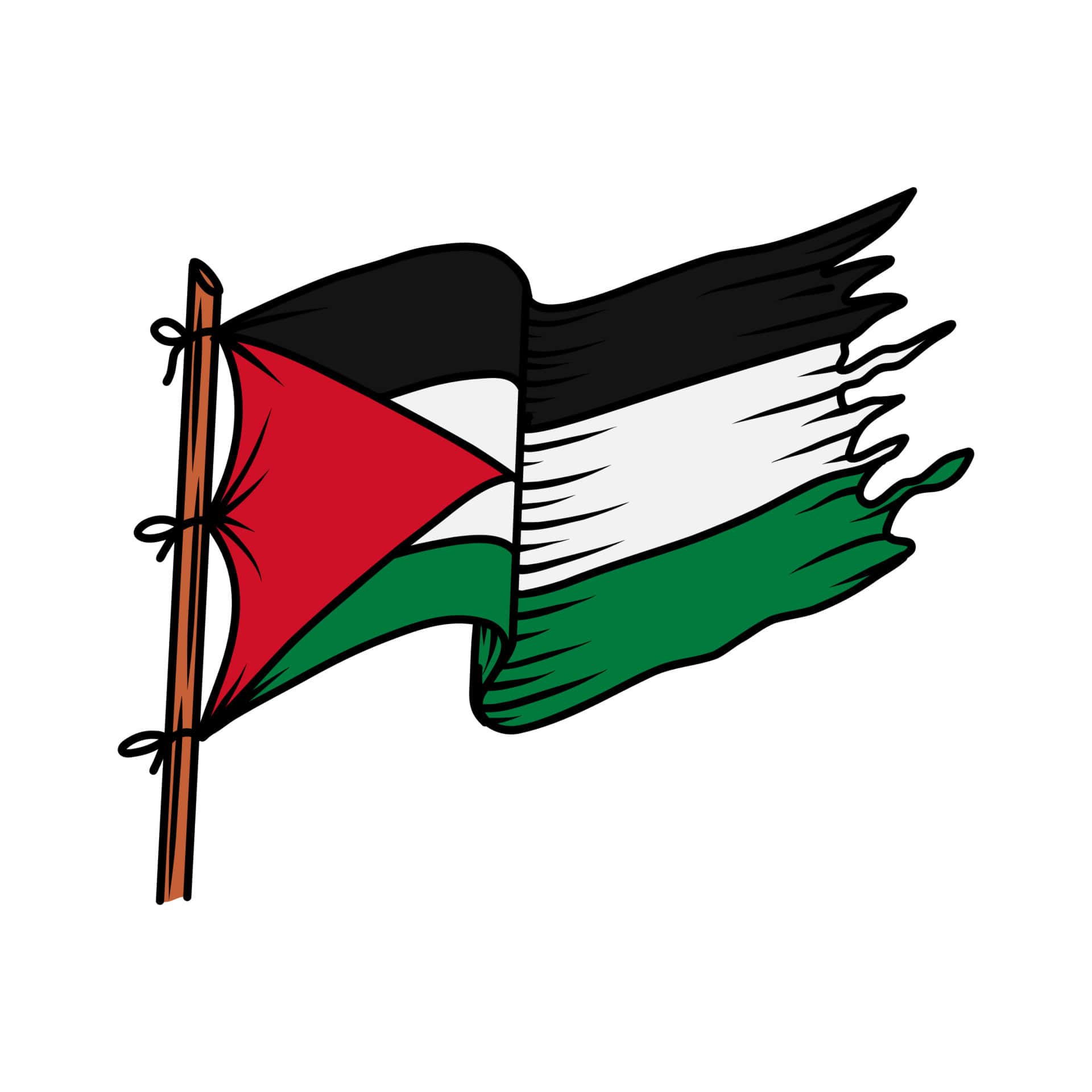Introduction
The Palestine flag is not just a piece of fabric; it is a powerful emblem of national identity, historical struggle, and a hopeful vision for the future. This symbol, rich in meaning and history, resonates deeply with Palestinians and supporters of their cause worldwide. In this blog, we will explore the origins, design, symbolism, and significance of the Palestine flag, shedding light on its role in the Palestinian struggle for statehood and recognition.
Historical Origins of the Palestine Flag
The origins of the Palestine flag can be traced back to the early 20th century, during a time of great upheaval and change in the Middle East. The flag’s design was inspired by the flag of the Arab Revolt against Ottoman rule (1916-1918). This revolt was a seminal event, marking the rise of Arab nationalism and the desire for self-determination.
The Palestine flag was officially adopted by the Palestinian Liberation Organisation (PLO) in 1964. However, its roots in the Arab Revolt give it a broader historical context, linking the Palestinian struggle to the wider Arab nationalist movement. The colours of the Palestine flag—black, white, green, and red—are known as the Pan-Arab colours, symbolising Arab unity and identity.
Design and Symbolism of the Palestine Flag
The Palestine flag features three horizontal stripes of black, white, and green, with a red triangle on the hoist side. Each colour has deep symbolic significance:
- Black represents the Abbasid Caliphate, a powerful Islamic dynasty that ruled much of the Arab world in the Middle Ages. It symbolises strength, endurance, and resilience.
- White symbolises the Umayyad Caliphate, another influential Islamic dynasty. It represents peace, honesty, and the aspirations for a brighter future.
- Green is associated with the Fatimid Caliphate and is a traditional colour in Islam, symbolising prosperity, fertility, and hope.
- Red represents the Hashemite dynasty and the blood of those who have sacrificed their lives for the Palestinian cause. It stands for courage, sacrifice, and the ongoing struggle for freedom and justice.
The design of the Palestine flag, with its combination of these significant colours, is a powerful reminder of the rich and diverse history of the Arab world. It underscores the deep cultural and historical roots of the Palestinian people, their shared heritage with the broader Arab community, and their enduring struggle for self-determination.

The Palestine Flag in Modern Times
In modern times, the Palestine flag has become an iconic symbol of Palestinian identity and resistance. It is a common sight at protests, rallies, and demonstrations around the world, symbolising solidarity with the Palestinian cause. The flag is also flown on significant days such as Nakba Day, which commemorates the displacement of Palestinians in 1948, and during events like the annual International Day of Solidarity with the Palestinian People.
The Palestine flag’s presence at these events underscores its role as a unifying symbol, bringing together Palestinians from diverse backgrounds and supporters from different nationalities. It is a visual representation of the Palestinian people’s unwavering commitment to their rights and aspirations for a sovereign state.
The Palestine Flag and International Recognition
The quest for international recognition of the Palestine flag has been a significant aspect of the Palestinian struggle. In 2015, the United Nations General Assembly voted to allow the Palestine flag to be flown at the UN headquarters in New York, a symbolic victory for the Palestinian cause. This decision was a recognition of Palestine’s status as a non-member observer state at the UN and a step towards greater international acknowledgement of Palestinian statehood.
The sight of the Palestine flag flying alongside those of other nations at the UN is a powerful reminder of the Palestinians’ quest for legitimacy and recognition on the world stage. It symbolises their hope for a future where they can live in peace and security within their own borders.
The Palestine Flag in Popular Culture
The Palestine flag has also found its way into popular culture, appearing in various forms of media and art. It is featured in music videos, films, and artworks, often as a symbol of resistance and solidarity. For example, the flag is prominently displayed in the works of Palestinian artists like Naji al-Ali, whose iconic cartoon character Handala is often depicted holding the flag.
In music, the Palestine flag is frequently seen at concerts and music festivals, especially those featuring artists who support the Palestinian cause. This presence in popular culture helps to keep the Palestinian struggle in the public eye, raising awareness and garnering support from a global audience.
Conclusion
The Palestine flag is more than just a national symbol; it is a beacon of hope, resilience, and unity for the Palestinian people. Its design, rooted in the rich history of the Arab world, encapsulates the struggles and aspirations of a nation striving for recognition and self-determination. As the flag continues to be flown at protests, rallies, and international forums, it serves as a reminder of the enduring spirit of the Palestinian people and their unwavering quest for justice and peace.
In every fold of the Palestine flag lies a story of courage, sacrifice, and hope. It is a testament to the resilience of a people who, despite decades of hardship and adversity, continue to strive for a better future. The flag’s powerful symbolism and historical significance ensure that it will remain a central emblem of the Palestinian identity and struggle for generations to come.
The Call to Free Palestine: A Journey of Struggle, Hope, and Resilience

Introduction
The call to “free Palestine” resonates deeply with people worldwide who advocate for justice, human rights, and self-determination. This phrase encapsulates a long-standing struggle against occupation, displacement, and injustice that has impacted generations of Palestinians. In this article, we will delve into the historical context, current realities, and the enduring hope that fuels the movement to free Palestine, aiming to shed light on the complexities and the human spirit driving this cause.
Historical Context of the Free Palestine Movement
To understand the call to free Palestine, one must look back at the historical roots of the conflict. The modern struggle for a free Palestine began in the early 20th century, amidst the decline of the Ottoman Empire and the rise of British colonial influence in the Middle East. The Balfour Declaration of 1917, which promised a homeland for Jews in Palestine, set the stage for future conflict by ignoring the political rights of the indigenous Arab population.
The Nakba, or “catastrophe,” of 1948 marked a turning point in Palestinian history. Over 700,000 Palestinians were displaced, and the state of Israel was established on much of the land previously inhabited by Palestinians. This event is central to the free Palestine movement, symbolising the beginning of a prolonged period of displacement, occupation, and resistance.
The Human Cost of Occupation
The human cost of the ongoing conflict is immense and forms the core of the plea to free Palestine. Palestinians living in the occupied territories of the West Bank, Gaza Strip, and East Jerusalem face daily challenges that include military checkpoints, restricted movement, and limited access to essential resources like water, healthcare, and education. The call to free Palestine is fundamentally about ending these hardships and restoring dignity to the Palestinian people.
In Gaza, the situation is particularly dire. Often referred to as the world’s largest open-air prison, Gaza has been under a blockade since 2007, severely restricting the flow of goods and people. The frequent military conflicts in the region have led to significant loss of life, destruction of infrastructure, and a humanitarian crisis that cries out for a resolution. Free Palestine is a demand for an end to this suffering and the establishment of conditions for a prosperous and peaceful future.
International Solidarity and the Free Palestine Movement
The movement to free Palestine has garnered significant international support over the decades. Solidarity with the Palestinian cause is expressed through various forms of activism, including protests, boycotts, and advocacy. The Boycott, Divestment, Sanctions (BDS) movement, initiated in 2005, aims to apply economic and political pressure on Israel to comply with international law and respect Palestinian rights. BDS has become a cornerstone of the global effort to free Palestine, uniting activists, academics, artists, and ordinary citizens in a common cause.
Numerous international organisations, including the United Nations, have called for a fair and just solution to the Israeli-Palestinian conflict. Resolutions passed by the UN General Assembly and Security Council have underscored the need to end the occupation and recognise Palestinian statehood. The call to free Palestine is thus not only a localised struggle but a global movement rooted in the principles of justice and human rights.
Cultural Resistance and the Spirit of Free Palestine
Cultural resistance plays a vital role in the free Palestine movement. Palestinian art, literature, music, and dance have become powerful tools for expressing national identity, resilience, and resistance. Artists like Mahmoud Darwish, a renowned Palestinian poet, have used their work to articulate the pain, hope, and dreams of the Palestinian people. His poetry, rich with themes of exile and longing for a homeland, continues to inspire those who strive to free Palestine.
The role of education and storytelling is equally crucial. Documentaries, films, and books about the Palestinian experience help to raise awareness and humanise the struggle. They offer a narrative counter to the often one-sided portrayal of the conflict in mainstream media. By sharing personal stories of loss, resilience, and hope, these cultural expressions reinforce the call to free Palestine, highlighting the human aspect of the political struggle.
The Role of Youth in the Free Palestine Movement
The youth are the lifeblood of the free Palestine movement. Young Palestinians, both in the diaspora and within the occupied territories, are at the forefront of advocacy and resistance. They utilise social media and digital platforms to share their stories, organise protests, and mobilise international support. The energy and innovation brought by the younger generation are vital in keeping the call to free Palestine vibrant and dynamic.
Education is a critical component of youth activism. Programmes that offer scholarships and educational opportunities to Palestinian students help to empower the next generation. By investing in education, the free Palestine movement not only addresses immediate humanitarian needs but also builds the foundation for a future Palestinian state that is knowledgeable, skilled, and capable of self-governance.
Pathways to Peace and the Vision of a Free Palestine
The vision of a free Palestine encompasses a peaceful and just resolution to the conflict. It involves recognising the rights of all peoples in the region and ensuring security and prosperity for both Palestinians and Israelis. Various peace initiatives, such as the Oslo Accords and the Arab Peace Initiative, have sought to outline frameworks for a two-state solution, which remains a widely supported vision for achieving peace.
Hqowever, achieving a free Palestine requires genuine commitment from all parties involved. It demands an end to the occupation, the dismantling of illegal settlements, and the recognition of Palestinian statehood. It also requires addressing the right of return for Palestinian refugees and ensuring that any peace agreement respects international law and human rights.
Conclusion
The call to free Palestine is a call for justice, dignity, and human rights. It is a movement deeply rooted in a historical context of displacement and occupation, but equally grounded in the enduring hope and resilience of the Palestinian people. The struggle to free Palestine is not just about borders and territories; it is about the right to live in peace, to thrive, and to determine one’s own future.
As the world continues to witness the unfolding events in the Middle East, the movement to free Palestine remains a powerful reminder of the universal desire for freedom and justice. By understanding and supporting this cause, we contribute to a more just and peaceful world, where the aspirations of all people are respected and realised. The journey to free Palestine is long and challenging, but it is driven by an unyielding belief in the possibility of a better, fairer future for all.

